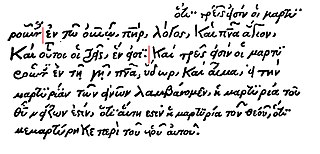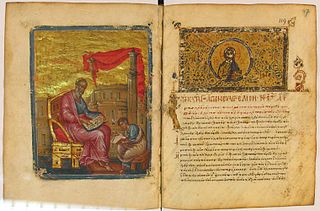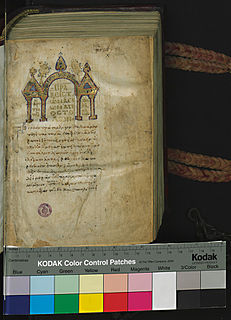Related Research Articles

Codex Mosquensis I designated by Kap or 018, Απρ1 (Soden), is a Greek uncial manuscript of New Testament, palaeographically it has been assigned to the 9th century. The manuscript is lacunose.

Minuscule 33, δ 48 (Soden), before the French Revolution was called Codex Colbertinus 2844. It is a Greek minuscule manuscript of the New Testament on parchment, dated palaeographically to the 9th century. The manuscript is lacunose. It has marginalia. According to the textual critics it is one of the best minuscule manuscripts of the New Testament.

Codex Montfortianus designated by 61, and known as Minuscule 61 is a Greek minuscule manuscript of the New Testament on paper. Erasmus named it Codex Britannicus. Its completion is dated on the basis of its textual affinities to no earlier than the second decade of the 16th century, though a 15th-century date is possible on palaeographic grounds. The manuscript is famous for including a unique version of the Comma Johanneum. It has marginalia.
Minuscule 81, or α162 is a Greek minuscule manuscript of the New Testament, on a parchment. It is dated by a colophon to the year 1044. Formerly it was labelled by 61a and 61p (Gregory). The manuscript is lacunose. It was adapted for liturgical use.

Minuscule 1739, α 78, is a Greek minuscule manuscript of the New Testament, on 102 parchment leaves. It is dated paleographically to the 10th century.

Minuscule 1424, δ 30 is a Greek minuscule manuscript of the New Testament, written on 337 parchment leaves. It has been dated paleographically to the 9th or 10th century).

Minuscule 104, α 103 (Soden), is a Greek minuscule manuscript of the New Testament, on parchment leaves. Palaeographically it has been assigned to the 11th century.
Minuscule 181, α 101 (Soden), is a Greek minuscule manuscript of the New Testament, on parchment. Palaeographically it has been assigned to the 11th century.
Minuscule 216, α 469 (Soden), is a Greek minuscule manuscript of the New Testament, on paper. It is dated by a colophon to the year 1358. It has marginalia.
Minuscule 221, α69 (Soden), is a Greek minuscule manuscript of the New Testament, on parchment. Paleographically it has been assigned to the 10th century. Scrivener labelled it by 212a and 250p. It has marginalia.
Minuscule 307, Aπρ11 (Soden), is a Greek minuscule manuscript of the New Testament, on parchment. Palaeographically it has been assigned to the 10th century. It has marginalia. Aland's III Category.
Minuscule 326, α 257 (Soden), is a Greek minuscule manuscript of the New Testament, on parchment. Paleographically it has been assigned to the 10th century. Formerly it was labelled by 33a and 39p . It was prepared for liturgical use.

Minuscule 330, δ 259 (Soden), is a Greek minuscule manuscript of the New Testament, on parchment. Palaeographically it has been assigned to the 12th century. It has marginalia. The Greek text of the codex is a representative of the Byzantine text-type.
Minuscule 431, δ 268, is a Greek minuscule manuscript of the New Testament, on parchment. Palaeographically it has been assigned to the 12th century. It has marginalia. It is known as Codex Molsheimensis.
Minuscule 436, α 172, is a Greek minuscule manuscript of the New Testament, on parchment. Palaeographically it has been assigned to the 11th or 12th century. Formerly it was labelled by 73a and 80p.

Minuscule 456, α 52, is a Greek minuscule manuscript of the New Testament, on parchment. Palaeographically it has been assigned to the 10th century. Formerly it was labelled by 86a, 96p, and 75r. Marginalia are incomplete. The manuscript was prepared for liturgical use.
Minuscule 614, α 364, is a Greek minuscule manuscript of the New Testament, on parchment. Palaeographically it has been assigned to the 13th century. The manuscript is lacunose. Tischendorf labelled it by 137a and 176p.
Minuscule 623, α 173, is a Greek diglot minuscule manuscript of the New Testament, on parchment. It is dated by a colophon to the year 1037. The manuscript is lacunose. Tischendorf labeled it by 156a and 190p.
Minuscule 629, α 460, is a Latin–Greek diglot minuscule manuscript of the New Testament, on parchment. It is known as Codex Ottobonianus. Palaeographically it has been assigned to the 14th century. The manuscript is lacunose. It is known for the Comma Johanneum.
Minuscule 630, α 461, is a Greek minuscule manuscript of the New Testament, on paper. It is known as Codex Ottobonianus. Palaeographically it has been assigned to the 12th or 13th century. The manuscript is lacunose. Formerly it was labeled by 163a and 201p.
References
- 1 2 Gregory, Caspar René (1908). Die griechischen Handschriften des Neuen Testament. Leipzig: J. C. Hinrichs'sche Buchhandlung. p. 51.
- 1 2 3 K. Aland; M. Welte; B. Köster; K. Junack (1994). Kurzgefasste Liste der griechischen Handschriften des Neues Testaments. Berlin, New York: Walter de Gruyter. p. 51.
- 1 2 3 Scrivener, Frederick Henry Ambrose; Edward Miller (1894). A Plain Introduction to the Criticism of the New Testament . Vol. 1 (4 ed.). London: George Bell & Sons. p. 291.
- 1 2 Gregory, Caspar René (1900). Textkritik des Neuen Testaments. Vol. 1. Leipzig: J.C. Hinrichs. p. 271.
- ↑ NA26, p. 466.
- ↑ Bruce M. Metzger (2001). A Textual Commentary on the Greek New Testament. Stuttgart: Deutsche Bibelgesellschaft. pp. 499–500.
- ↑ Aland, Kurt; Aland, Barbara (1995). The Text of the New Testament: An Introduction to the Critical Editions and to the Theory and Practice of Modern Textual Criticism. Erroll F. Rhodes (trans.). Grand Rapids: William B. Eerdmans Publishing Company. p. 129. ISBN 978-0-8028-4098-1.
- ↑ UBS3, p. 448
- ↑ The Greek New Testament, ed. K. Aland, A. Black, C. M. Martini, B. M. Metzger, and A. Wikgren, in cooperation with INTF, United Bible Societies, 3rd edition, (Stuttgart 1983), p. 524.
- ↑ UBS3, p. 548.
- ↑ UBS3, p. 581.
- ↑ The Greek New Testament , ed. K. Aland, A. Black, C. M. Martini, B. M. Metzger, and A. Wikgren, in cooperation with INTF, United Bible Societies, 3rd edition, (Stuttgart 1983), p. 724.
- ↑ UBS3, p. 823.
- ↑ Bart D. Ehrman, The Orthodox Corruption of Scripture, Oxford University Press, Oxford 1993, p. 60.
- ↑ Bruce M. Metzger, The Text of the New Testament (Oxford 2005), p. 147.
- ↑ Ernst von Dobschütz, "A hitherto unpublished Prologue to the Acts of the Apostles", AJT 2 (Baltimore, 1898), pp. 353–387.
- ↑ "Liste Handschriften". Münster: Institute for New Testament Textual Research. Retrieved 2022-02-15.